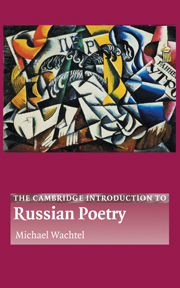Book contents
- Frontmatter
- Contents
- Preface
- Acknowledgments
- Note on translations and transliterations
- Introduction
- Part I Concepts
- Chapter 1 Versification: how to do things with words
- Chapter 2 Poetic language
- Chapter 3 Tradition and the individual talent
- Part II Interpretation
- Conclusion: poetry and pattern
- Bibliography
- Suggested further reading
- Index of poetic terms
- Index of names and works
Chapter 1 - Versification: how to do things with words
Published online by Cambridge University Press: 05 June 2012
- Frontmatter
- Contents
- Preface
- Acknowledgments
- Note on translations and transliterations
- Introduction
- Part I Concepts
- Chapter 1 Versification: how to do things with words
- Chapter 2 Poetic language
- Chapter 3 Tradition and the individual talent
- Part II Interpretation
- Conclusion: poetry and pattern
- Bibliography
- Suggested further reading
- Index of poetic terms
- Index of names and works
Summary
Кака́я глубина́!
Кака́я сме́лость и кака́я стро́йность!
Пушкин, «Мо́царт и Салье́ри»What profundity!
What daring and what just proportion!
Pushkin, “Mozart and Salieri”All forms of communication – both artistic and quotidian – are based on rules. These rules may be arbitrary, but we depend on them nonetheless. There is no particular reason why a red light should mean “stop” and a green light “go,” but drivers or pedestrians who disregard this binary opposition will not survive long. Likewise, it is hard to explain logically why English speakers call that tall plant with branches and leaves a “tree,” while Russians call it a “derevo,” but the fact is that English-speakers and Russian-speakers have agreed, consciously or not, to respect these designations.
When we speak English, we rarely appreciate its complexity. We do not struggle to make the subject agree with the verb, but this is not because English lacks rules (or that one need not know them), but precisely because we know them so well that they have become automatic. Studying a foreign language teaches us, among other things, the ubiquity and necessity of grammar.
Like any other language, poetry has its own grammar: versification. Of course, obeying this set of rules does not guarantee brilliant verse, just as following the rules of English grammar will not necessarily produce scintillating conversation. But it is only within an agreed-upon system that brilliance can stand out.
- Type
- Chapter
- Information
- The Cambridge Introduction to Russian Poetry , pp. 15 - 34Publisher: Cambridge University PressPrint publication year: 2004



